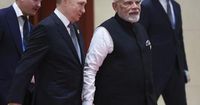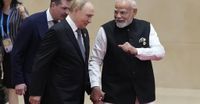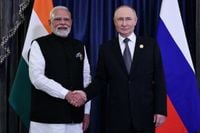In a display of diplomatic warmth and strategic alignment, Indian Prime Minister Narendra Modi and Russian President Vladimir Putin met on September 1, 2025, on the sidelines of the Shanghai Cooperation Organization (SCO) summit in Tianjin, China. Against a backdrop of rising tensions between New Delhi and Washington, the encounter underscored the deepening relationship between India and Russia, with both leaders hailing their nations’ enduring partnership as “special and privileged.”
The summit, hosted in the bustling port city of Tianjin, brought together regional heavyweights to discuss pressing issues of stability, trade, and energy cooperation. But it was the meeting between Modi and Putin that drew the most attention, occurring just days after U.S. President Donald Trump imposed a steep 25% increase in tariffs on Indian imports—raising the total to a formidable 50%—in retaliation for India’s continued purchases of discounted Russian oil. As the world’s third-largest importer of crude, after China and the United States, India now sources about 37% of its oil from Russia, a dramatic shift that has reshaped global energy flows since the outbreak of the war in Ukraine.
According to AP, Modi described the partnership with Moscow as “special and privileged,” a sentiment echoed by Putin, who called Modi a “dear friend” and emphasized, “Russia and India have maintained special relations for decades. Friendly, trusting. This is the foundation for the development of our relations in the future.” Putin further stressed that these ties are “absolutely non-partisan in nature, supported by the overwhelming majority of the peoples of our countries,” as reported by IANS.
The personal rapport between the two leaders was on full display. Before their formal talks, Modi and Putin spent nearly an hour conversing privately in a Russian-made Aurus limousine, a detail highlighted by Russian state media and noted by Vijesti. Moments before joining other summit leaders for a group photo, Modi clasped Putin’s hand with the familiarity of an old friend, both men sharing smiles and laughter. Even Chinese President Xi Jinping, standing nearby, offered a measured smile, hinting at the significance of this trilateral moment amidst shifting geopolitical sands.
While the SCO meeting’s official agenda focused on regional stability and cooperation, the shadow of the Russia-Ukraine conflict loomed large. Modi used the platform to call for an end to the conflict and the establishment of lasting peace, stating, “To end the conflict as soon as possible and establish lasting peace, we must find a way. This is the call of all humanity.” His words, reported by Morung Express and IANS, reflected India’s consistent position advocating for a peaceful resolution and support for recent international initiatives aimed at halting the war.
Putin, for his part, acknowledged the constructive roles played by India, China, and other strategic partners in seeking a settlement to the Ukrainian crisis. He remarked, “We highly value the efforts and proposals of China, India and our other strategic partners, aimed at facilitating the settlement of the Ukrainian crisis.” Putin also referenced “understandings” reached with U.S. President Donald Trump at a summit in August, suggesting these opened a path toward peace in Ukraine—a rare nod to ongoing backchannel diplomacy.
The timing of the Modi-Putin meeting was significant. Trump’s imposition of additional tariffs on Indian imports, specifically targeting India’s Russian oil purchases, has tested the resilience of U.S.-India ties. Washington has repeatedly warned New Delhi that buying Russian crude helps fund Moscow’s war effort, but India has defended its imports as essential to meet the energy needs of its 1.4 billion citizens. “India has always walked shoulder-to-shoulder with Russia, even in the most difficult times,” Modi asserted, highlighting not just historical ties but also a sense of strategic autonomy in India’s foreign policy.
Trade between India and Russia has surged in recent years. Data from the Indian government, cited by AP and Vijesti, shows that bilateral trade reached a record $68.7 billion in the 2024-25 financial year. Of this, imports from Russia were around $64 billion, while Indian exports to Russia stood at approximately $5 billion. Both nations have set an ambitious goal to boost total trade to $100 billion by 2030, with energy cooperation forming the backbone of this expansion.
Beyond oil, Modi and Putin discussed expanding collaboration in sectors ranging from fertilizers and space to security and culture. The leaders expressed satisfaction with the sustained growth in bilateral ties and reaffirmed their commitment to strengthening the Special and Privileged Strategic Partnership. “Tourist exchange is developing. We closely coordinate our efforts in the international arena: the UN, BRICS, the Group of Twenty and, of course, the SCO,” Putin noted, highlighting the multi-level nature of the relationship.
Modi also looked ahead, expressing eagerness to host Putin in India for the 23rd Annual India-Russia Summit in December 2025. “The 1.40 crore Indians are eagerly waiting for the Russian President’s arrival,” Modi said, underscoring the anticipation surrounding Putin’s upcoming visit, which will mark 15 years since the two nations elevated their partnership to the level of a “special privileged strategic partnership.”
Analysts have observed that the current U.S. approach—characterized by economic pressure and a more confrontational tone—has nudged India closer to both Russia and China, at least in the context of multilateral forums like the SCO. Harsh Pant, vice president of foreign policy at the Observer Research Foundation, told AP, “Trump’s policies are accelerating a process whereby India seems to be working much more closely with China and Russia to push back against economic unilateralism it is witnessing from the U.S.”
Despite the recent turbulence, Indian officials and experts remain hopeful that the friction with Washington is temporary. Sreeram Sundar Chaulia of the Jindal School of International Affairs suggested that India’s long-term strategy is to maintain strong ties with both the U.S. and Russia, remarking, “Then, India can return happily to having the Russian cake and eating the American pie as part of its multi-alignment strategy.”
As the Tianjin summit concluded, Trump continued to voice his frustrations, posting on social media that the U.S.-India trade relationship “has been a totally one-sided disaster!” and signaling that a new trade deal was unlikely in the near term. “They have now offered to cut their Tariffs to nothing, but it’s getting late. They should have done so years ago. Just some simple facts for people to ponder!!!” the U.S. president wrote, as reported by AP.
For now, the Modi-Putin meeting stands as a vivid reminder of the shifting currents in global diplomacy. As India and Russia reaffirm their close ties and look to expand cooperation, the world watches to see how these evolving alliances will shape the balance of power—not just in Eurasia, but far beyond.






